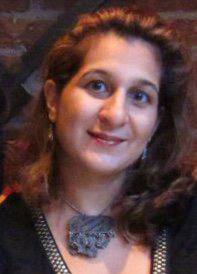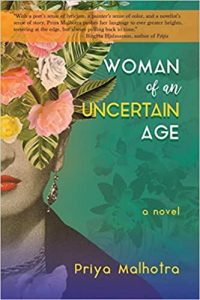THE UNEXPECTED DISCLOSURE THAT SPARKED WOMAN OF AN UNCERTAIN AGE
THE UNEXPECTED DISCLOSURE THAT SPARKED WOMAN OF AN UNCERTAIN AGE
 Several years ago, I met an Indian-American girl at a wedding in a large U.S. city and we started talking. She grew up comfortably in the United States with a professional father and a stay-at-home mother, and I got the sense that her family was one of those that is both traditional and modern, like many Indian families in America. She was in her late twenties and studying to become a psychotherapist, and, as we drank some wine, she started to disclose some interesting things. Her father had died not too long ago, and her mother, whom I pictured as a motherly, straitlaced fifty-something Indian woman with neatly-tied long hair, had a boyfriend.
Several years ago, I met an Indian-American girl at a wedding in a large U.S. city and we started talking. She grew up comfortably in the United States with a professional father and a stay-at-home mother, and I got the sense that her family was one of those that is both traditional and modern, like many Indian families in America. She was in her late twenties and studying to become a psychotherapist, and, as we drank some wine, she started to disclose some interesting things. Her father had died not too long ago, and her mother, whom I pictured as a motherly, straitlaced fifty-something Indian woman with neatly-tied long hair, had a boyfriend.
This took me by surprise. I had rarely heard of an Indian woman of that age, particularly someone with two or three daughters in their twenties, the classic marriageable age, have a boyfriend. “Was your mother always a progressive sort?” I asked the girl, trying to disguise my amazement. “No”, she replied. “And you would never know it by looking at her. After my father died, something in her broke loose.”
I was really intrigued. We drank some more and she continued talking. One time, her mother had asked her if she could talk to her about something, not as a daughter but as a therapist. “I told her I didn’t think that was appropriate, but she insisted, saying she had no one else to talk to about this,” the girl said, her expressive face looking like it was still befuddled by that conversation.
“Then my mom told me that there’s something that he (the mother’s boyfriend) likes her to do to him, but doesn’t like to reciprocate – she was referring to something sexual, if you know what I mean,” the girl revealed. “She wanted me to give her advice on how to handle the situation.”
Now, I was completely stunned. I didn’t know too many women of any culture who would talk to their daughters like this, let alone an Indian woman.
After the wedding, the girl and I parted ways but I couldn’t stop thinking about her mother. Who was she? Why did she ask her daughter something so intimate instead of going to a therapist? Was she, like many Indians, wary of going to a therapist? What had her marriage been like? What had given her the courage to have a boyfriend? Was she open about it amongst other Indians? The image of this woman whom I have never met and had no more information about started forming in my mind, my mind slowly filling in the numerous blanks. This image was the seed that eventually blossomed into the character of my protagonist Naina.
Growing up in India, I generally saw people conform to the age-related expectations of the time. Almost everyone I knew went to college right after high school, and some girls got married soon after college. Others pursued graduate degrees and took up careers, but were generally married in their twenties. And the same thing happened in my parents’ generation, but fewer women worked outside the home.
In New Delhi, the city I grew up in, a woman, whose two adolescent daughters I knew, lost her husband when she was in her early forties. I recall wondering if she would ever marry again, ever feel the touch of a man’s skin on her again. (As a teenage girl, I would spend my time thinking about such things:} I asked someone, an older lady if I recall correctly, if this aunty would marry again and she shook her head and said – “Priya, don’t ask silly questions.” I don’t think it even occurred to anyone to think that the newly-widowed lady, who is now in her eighties and still single, would ever remarry.
As the picture of my protagonist Naina started to emerge in a stream of consciousness way, which is the way I write, I became curious about middle-aged women’s lives and about the relationship between grown-up daughters and mothers. What happens when a middle-aged mother wants to undertake the journey of finding herself, the classic rite of passage of a young person? What happens when she, at an age when she is expected to be mature and sensible, is open, vulnerable, impulsive and prone to making mistakes? What happens when that woman loses the authority of being older and the mother figure and the daughter takes on the responsible adult role? What are the consequences of that role reversal? And, what is the relationship between age and wisdom? In India, older people are generally respected and assumed to be wise, but in the West the link between age and wisdom is so much more ambiguous.
As I was thinking about writing my novel, there was so much out there about the lives of women in their twenties and thirties–a plethora of chick lit and films and TV shows. But I saw much fewer explorations, at least serious explorations, of the lives of contemporary middle-aged women. For me, these women, particularly those from traditional cultures living in the United States, were interesting because they were caught between conventional expectations and a mainstream culture that constantly questions age-related notions, an environment where the perpetual quest for youth seems to be more urgent and insistent than ever.
I read a great deal and found British writer Anita Brookner’s intense renditions of the inner lives of middle-aged women to have great psychological acuity, and I learned a lot from her books. Anne Tyler’s Ladder of Years, a quirky tale of a middle-aged woman suddenly leaving her husband and children, impressed me with its ability to portray its flawed protagonist in both a sympathetic and unsentimental way.
And as I started to write my novel, I could hear the whispers of my favorite authors in the back my head; Gabriel Garcia Marquez, Anais Nin, Nicole Krauss, Pankaj Mishra, Hari Kunzru, Salman Rushdie, Julia Glass, Kiran Desai, Isabel Allende, Bharati Mukherjee, to name just a few. They urged me to create, sent me an image when none would come, showed me the way to keep the plot tight and moving when it started to sag. And then there was my husband who urged me in what was definitely not a whisper to keep writing. Hopefully, the result, which took several years to create, is interesting, thought-provoking, enjoyable, and above all, a story that many across the globe can relate to at a time when assumptions regarding age and motherhood are relentlessly being challenged.
—
Priya Malhotra is the author of the novel “Woman of An Uncertain Age.”
She has been a writer and journalist in New York for about 20 years and has contributed to Newsday, Time Out New York, The Times of India, The Japan Times, Asian Art News, Cosmopolitan and News India Times. In 2002, Priya explored why American women converted to Islam in an article for leading newspaper Newsday, and, subsequently, reference book publisher H.W. Wilson included it in a compilation of important articles on religion in politics and society from esteemed national publications such as The New York Times and Atlantic Monthly. Priya has a Master’s degree in journalism from Columbia University in New York City and a Bachelor’ s degree in English literature from Kenyon College in Gambier, Ohio.
She is represented by Jennifer Lyons of Jennifer Lyons Literary Agency whose clients include luminaries such as Jesmyn Ward who made history by becoming the first woman and African-American to win the National Book Award for fiction twice. The agency also represents the estates of Gabriela Mistral, the late Chilean Poet and first Latin American to win the Nobel Prize for literature, and Oscar Hijuelos, the late Cuban-American novelist and first Hispanic writer to win the Pulitzer Prize for fiction.
Facebook: https://m.facebook.com/priya.malhotra.771
Twitter: writer_priya
Instagram: writer_priya12
WOMAN OF AN UNCERTAIN AGE
 Woman of An Uncertain Age has been named as one of the most anticipated books released in September 2022 along with novels by acclaimed authors like Elizabeth Strout and Kamila Shamsie by Bustle Magazine.
Woman of An Uncertain Age has been named as one of the most anticipated books released in September 2022 along with novels by acclaimed authors like Elizabeth Strout and Kamila Shamsie by Bustle Magazine.
“In her debut novel, India-born, New York—based journalist Malhotra vividly portrays aspects of Indian immigrant life in the United States.”– Library Journal.
Woman of An Uncertain Age is Become A Good Ancestor’s Book Club pick for October 2022.
When fifty-something Naina Mehta’s husband dies of a heart attack, she transforms herself from a suburban wife into a bold woman thirsty for new experiences. A far cry from the classic image of the aging Indian widow who dresses in subdued colors and focuses solely on her children and God.
Naina moves to New York City, takes up a low-paying job in a contemporary art gallery, and becomes besotted by Jai, her daughter’s boyfriend. But that’s only the beginning of her journey into this new world that allows her to explore the possibilities of being who she wants to be.
As Naina becomes more empowered, she dips her toes into the world of dating for the first time in her life. Maybe the possibility of love still exists for a woman of her age. But what happens if the man in question is Muslim and stirs generational wounds and the wrath of her conservative son?
Woman of an Uncertain Age explores the rocky, uncertain terrain of a middle-aged widow during a time when the parameters and ideas of midlife are being challenged. What does it mean to be a fifty-plus woman with grown children in such an environment? Especially for Naina, who comes from a culture where life is expected to follow a strict traditional course.
Amazon link for book: https://www.amazon.com/Woman-Uncertain-Age-Priya-Malhotra/dp/1949290905
Category: On Writing






























